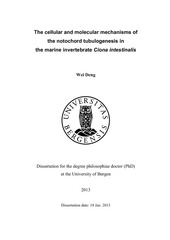The cellular and molecular mechanisms of the notochord tubulogenesis in the marine invertebrate Ciona intestinalis
Doctoral thesis
Permanent lenke
https://hdl.handle.net/1956/6526Utgivelsesdato
2013-01-18Metadata
Vis full innførselSamlinger
Sammendrag
The biological tube is the fundamental structural design of most internal organs and body systems. Tubulogenesis involves a series of coordinated cellular processes, failure of any of which can cause severe dysfunctions in the organism. Therefore, the study of tube formation can increase our knowledge of the cellular and developmental mechanisms of morphogenesis, and furthers our understanding of a number of human diseases. Among various models for tubulogenesis in animal development, Ciona intestinalis notochord development features a unique cellular morphogenesis that constructs a simple tube. The mechanism underlying the notochord tubulogenesis is largely unexplored, and is what this thesis wishes to address. First, we explore the transcriptome of the Ciona notochord by microarray analysis, and expand the current inventory of notochord-specific genes. Second, employing 3D live confocal imaging, we demonstrate that components of the cytoskeletons, especially actin filaments, are involved in several cellular morphogenetic events during notochord tube formation. Third, we characterized a notochord-specific anion transporter, Ci-Slc26a, and reveal that its transport activity is essential for notochord lumen formation. Detailed analysis indicates that lumen formation is independent from other processes leading to notochord tubulogenesis. Overall, this work contributes to the understanding of molecular and cellular mechanisms of Ciona notochord tubulogenesis, and the roles of a Slc26 family transporter in the context of lumen formation.
Består av
Paper I: José-Edwards, D. S., Kerner, P., Kugler, J. E., Deng, W., Jiang, D. & Di Gregorio, A. 2011. The Identification of Transcription Factors Expressed in the Notochord of Ciona Intestinalis Adds New Potential Players to the Brachyury Gene Regulatory Network. Developmental Dynamics 240(7): 1793–1805, July 2011. Full text not available in BORA due to publisher restrictions. The article is available at: http://dx.doi.org/10.1002/dvdy.22656Paper II: Dong, B., Deng, W. & Jiang, D. 2011. Distinct Cytoskeleton Populations and Extensive Crosstalk Control Ciona Notochord Tubulogenesis. Development 138: 1631-1641, April 2011. Full text not available in BORA due to publisher restrictions. The article is available at: http://dx.doi.org/10.1242/dev.057208
Paper III: Sehring, I. M., Dong, B., Bhattachan, P., Denker, E., Deng, W. & Jiang, D. A cytokinesis-like actomyosin contractile mechanism drives cell elongation. Full text not available in BORA.
Paper IV: Deng, W., Nies, F., Feuer, Anja., Oliver, D. and Jiang, D. A Slc26 anion transporter is essential for lumen expansion during tubulogenesis. Full text not available in BORA.
